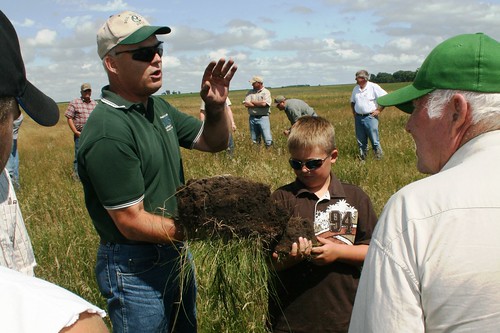
In this photo from the 2009 Society for Range Management (SRM) Award tour, Soil Quality Specialist, Rick Bednarek, formerly of SD, explained the darkness of the soil was due to the organic matter which is the key indicator of the health of soil.
Too often, it’s treated like dirt. But this week our living and life-giving soil is finally getting some of the respect it deserves today, for World Soils Day.
While soil may not enjoy the media attention of Thanksgiving, Christmas or New Year’s, it can be argued that it shares importance with all three. Where would we be without soil?
This amazing resource is responsible for nearly all life on the planet. Naturalist Aldo Leopold describes soil perfectly, saying: “Land is not merely soil, it is a fountain of energy flowing through a circuit of soils, plants and animals.”
Understandably, it’s easy to take soil for granted because it’s mostly hidden from view — and few who live off the farm have reason to give it a second thought. Fortunately, scientists, conservationists and farmers are increasingly recognizing that keeping our soil healthy and functioning is the key to our survival.
USDA’s Natural Resources Conservation Service and its conservation partners are working directly with private landowners to improve the health of the soil on our working lands. And by improving the health of the soil, we are also improving the health and vitality of our farms, families and communities.
This renewed focus on the health of our soil has created an exciting new revolution in American agriculture as farmers, ranchers and other landowners are increasingly making their land more productive and sustainable through soil health management systems.
Although all farming operations are different, most all can benefit from:
- keeping the soil covered as much as possible;
- disturbing the soil as little as possible;
- keeping plants growing throughout the year to feed the soil; and
- diversifying plants as much as possible using crop rotation and cover crops.
By improving soil health can harvest benefits on and off the farm including increasing farmland sustainability and resilience, improving water and air quality, providing wildlife habitat and reducing flooding.
This work ensures healthy soil will be plentiful for future generations.
World Soil Day serves as a reminder to all of us that we owe our existence to the soil. President Franklin Roosevelt says it best: “The nation that destroys the soil destroys itself.”
In naming Dec. 5 World Soil Day and 2015 as International Year of Soils, the Food and Agriculture Organization of the United Nations aimed to focus attention on something we see, touch, walk on and depend on every day – and should never take for granted.
As we face mounting global production, climate and sustainability challenges, I believe there is no better time to work hand-in-hand with farmers and ranchers to improve the health of this critical living resource.
For more information on soil, visit NRCS’ soil health awareness campaign, “Unlock the Secrets in the Soil.”

The South Dakota Legislature made Houdek (pronounced hoo-deck) the official State Soil in 1990. South Dakota has over 650 different soils.
No comments:
Post a Comment
Note: Only a member of this blog may post a comment.